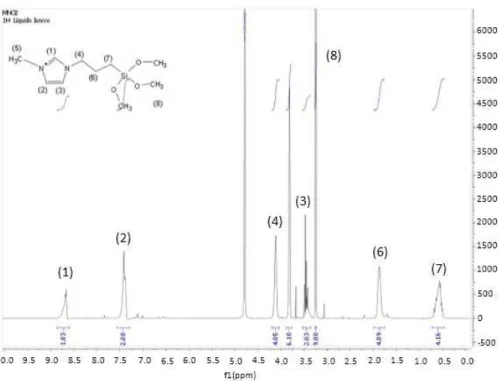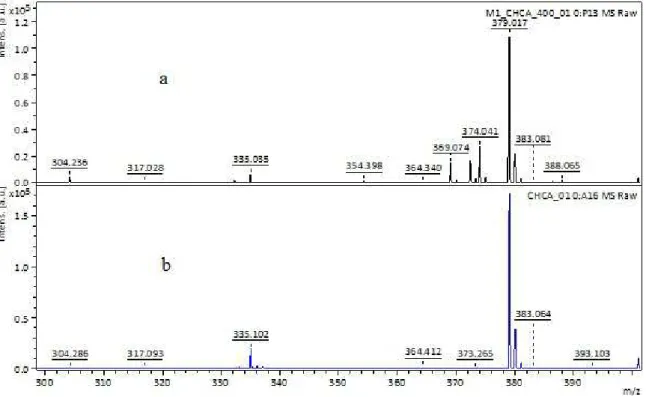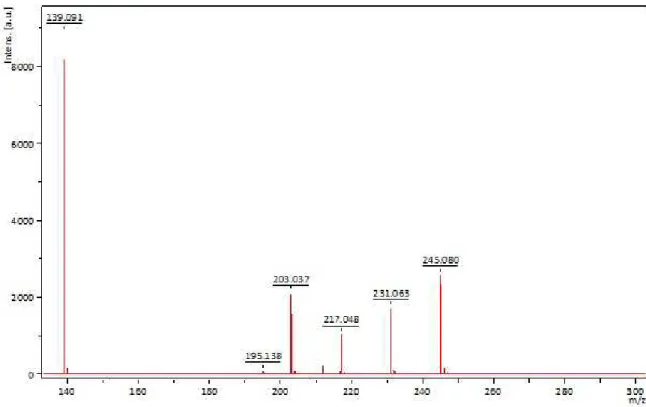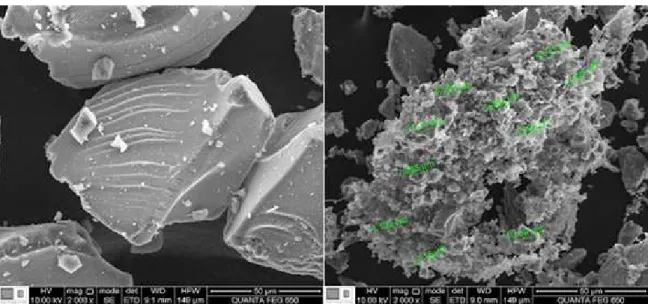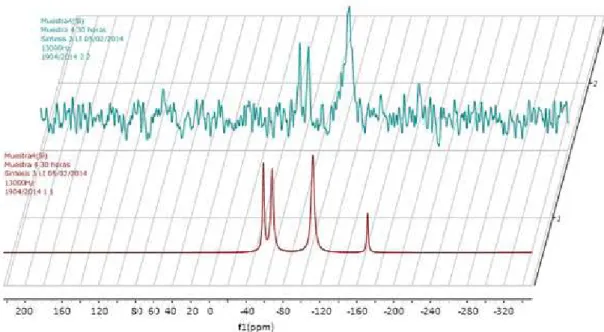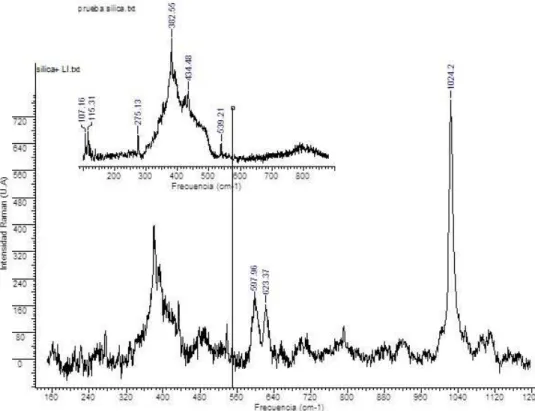*e-mail: lcarreno@uis.edu.co
Introduction
Silica is an inorganic material broadly used as catalytic support or material for chromatographic columns. Its preparation involves polycondensation of sylanol groups (-Si-OH) from orthosilicic acid (Si(OH)4). Through the synthesis, the silicon precursor can interact with porogenic agents or surfactants when added to the reaction media. This sort of substances form micelles, which keep trapped in the growing structure of siloxanes. As a result, a hybrid material is obtained, its organic component can be extracted with solvents otherwise can be calcined to give rise to a solid structure based on an irregular arrangement or irregular channels with silica walls. 1,2
Ionic liquids (IL) are a synthetic group of chemicals with a growing interest due to their unique properties including melting points below 100°C, negligible vapor pressures, high thermal stabilities, high viscosities, and the great number of anions and cations available 3 that allow tailoring the ionic liquids based on the applications. Due to all these properties,
there is a broad ield of potential applications; our interest is
as an extracting media. 4 The ionic liquid chloride 1-methyl-3-methyl imidazolium has been reported as a material with dehydrating properties 5,6
Industrial applications of ionic liquids offer environmental advantages but still have room for improvement, mainly due to their high costs and high viscosity that make applications expensive energetically and economically. In an effort to solve these issues, preparation of immobilized functional ionic liquids (IFILs) has emerged as a better option.7, 8 These kind of solid composites can be easier handled, separated, regenerated and re-used, the anchoring processes
have been used in catalytic processes including esteriication,
nitration, enzymatic reactions among others 9-11. The grafting method or valent anchoring method avoid IL leaching and involves an anchor group covalently attached to the surface
that is used as the cation in the formation of the ionic group,
in this way a thin il of IL is formed on the surface of the
support. Here we report the synthesis and characterization of a solid composite based on a mesoporous silica material, covalently bonded to the ionic liquid chloride 1- methyl-3-methoxysilyl propyl imidazolium with application in dehydration processes of industrial interest including natural gas or bioethanol among others.
1. Experimental
1.1 Synthesis of chloride 1-methyl-3-methoxysilyl
propyl imidazolium
Stoichiometric amounts of (3-chloropropyl) trimethoxy sylane (Merck S.A) and 1-methyl imidazolium (Merck, S.A.) were mixed and heated at 78°C under inert atmosphere and
relux. The produced chloride 1-methyl-3-methoxysilyl
propyl imidazolium was rotoevaporated, washed and dried under vacuum. A yellow viscous material was obtained with 78% yield. 12,13
1.2 Synthesis of mesoporous silica
For this synthesis, according to the nature of the surfactant and pH of the synthesis media, three main types of interactions are involved. In alkaline media, where the siliceous species bear negative charges (I-), the interactions with cationic surfactant (S+) are electrostatic (S+I-); 14 non-ionic surfactants (S0) used in neutral media, allow hydrogen bonds and Van der Waals interactions (S0I0). 15 In acidic media, the interaction between the silica and the surfactant is mediated by X- anions as described by S+X-I+11; in this case glycerol was used as porogenic agent (a renewable, non-toxic, highly available and cheap material) 16 and TEOS (tetraethoxysilane) (Merck S.A) as siliceous source. In the irst step, hybrid
Synthesis and Characterization of 1-Methyl-3-Methoxysilyl Propyl Imidazolium Chloride –
Mesoporous Silica Composite as Adsorbent for Dehydration in Industrial Processes
Javier F. Plata Liévanoa, Luz A. Carreno Díazb*
aEscuela de Ingeniería Metalúrgica y Ciencia de Materiales, Facultad de Fisicoquímicas,
Universidad Industrial de Santander, Colombia
bEscuela de Química, Facultad de Ciencias, Universidad Industrial de Santander,
Cra 27 calle 9 Campus Central Bucaramanga, Colombia
Received: September 17, 2015; Revised: January 14, 2016; Accepted: March 1, 2016
Ionic liquid – mesoporous silica composite was synthesized as a new adsorbent for dehydration in industrial processes. An ionic liquid (IL) with proved dehydration properties has been covalently anchored to mesoporous silica. The parameters of the synthesis were studied to produce a solid and stable composite. The material was then characterized by SEM, BET, FTIR, NMR, Raman, XRD,
XRF, MALDI and LDI conirming the presence of a covalent bond between the ionic liquid and the
solid matrix. Evaluations have shown that the material kept the IL dehydration property.
2016; 19(3) 535 Synthesis and Characterization of 1-Methyl-3-Methoxysilyl Propyl Imidazolium Chloride – Mesoporous Silica
Composite as Adsorbent for Dehydration in Industrial Processes
micelles were formed by interaction between the glycerol and TEOS under controlled pH. In the second step, the condensation reaction occurred by addition of NaF, which is both the starter of the poly-condensation reaction and the precursor of the material with meso- structural properties.
After evaluation of different reaction parameters it was determined that using CH3COOH at pH 2 as a reaction media, molar ratios TEOS: Glycerol and NaF:TEOS of 1:6 y 1:10, respectively and dried at 90°C for 12 hours, allows to synthesize SiO2 with 85% yield.
2.3 Synthesis of 1-methyl-3-methoxysilyl propyl
imidazolium chloride – mesoporous silica
composite
A mix of Ionic liquid/silica with a molar ratio of 0,2 was heated at 90°C for 24 hours, the produced composite was
iltered and then washed with methanol.
2.4 Characterization
FTIR and Raman spectra were recorded on a Tensor 27 Bruker with an ATR cell and a Raman confocal microscope LabRam High Resolution (HR) from Horiba, respectively. X-ray diffraction (XRD) patterns were recorded on a BRUKER model D8 ADVANCE equipped with a graphite
monochromator powder diffraction system using Cu Kα1
radiation of 0.15406 nm wavelength operated at 40 kV y 30 mA.
The BET (Brunauer–Emmett–Teller) speciic surface areas
were calculated using adsorption data in a relative pressure range of P/P0 = 0.05–0.25. Pore size distribution curve was calculated from the adsorption branch using the BJH (Barrett–Joyner–Halenda) method. The total pore volumes were estimated from the amounts adsorbed at a relative
pressure (P/P0) of 0.99. Quantitative analysis was performed by XRF on a dispersive wavelength instrument 4KW BRUKER model S8 TIGER. Scanning electron microscopy (SEM) was performed using a FE-SEM QUANTA FEG 650 (FEI) system with a LFD detector, at 7 kV equipped with EDX. NMR spectra were recorded on a Bruker Advance III 400 MHz Ultrashield. Mass spectra were recorded using LDI (Laser Desorption Ionization) and MALDI with CHCA as matrix
using a Bruker Ultralextreme MALDI TOF-TOF (Bruker
Daltonics, Billerica, MA).
2. Results and discussion
The ionic liquid was synthesized as explained before; the characterization included FTIR spectrum, the assignment of the spectrum bands corresponds with functional groups presents in its structure. KBr liquids cell: 3363 (OH), 3140
(C=C), 2947 (CH2), 2841 (CH3), 1568 (C=C) 1460 (CH3), 1182 (Si-O-CH3), 1070 (Si-O-CH3), 810(Si-C). These observations indicate that the organic silica structure keeps unchanged during the anchoring process. NMR spectrum allowed correlation of every type of signal to the corresponding protons in the molecular structure as shown in Figure 1.
1H NMR (400 MHz, D
20): δ (8.67, 2H) δ (7.56-7.29, 2H) δ (4.13, 4H) δ (3.82, 6H) δ (3.54-3.36, 2H) δ (3.25, 9H) δ (1.87, 4H) δ (0.73-0.46, 4H). Signals integration showed
duplicity for the corresponding signals of propyl imidazolium, which is explained by considering the presence of a cluster. Analysis by MALDI using CHCA as matrix was performed
to conirm the cluster formation; the approach shown
between 300 and 400 m/z in Figure 2 presents the m/z 369 corresponding to the cluster mass: the proposed structure for it is shown in Figure 3.
Additional characterization of the ionic liquid included analysis by laser desorption ionization (matrix free used for small molecules). The molecular mass of the ionic liquid is 280 Da, however the molecular ion is neutralized by the chloride counter ion, in consequence, the expected molecular ion must be 245 m /z as observed in the corresponding spectra shown in Figure 4.
SEM as shown in Figure 5 allowed observation of the synthesized silica morphology; amorphous particles are observed most of them with micrometric size as shown
at different optical magniications, the average sized is
between 90-120 µm, aggregates are not observed meaning a proper dried process of the gel. BET analysis determined an average surface area of 104.02 m2/g and an average pore
size of 28 nm. Quantitative analysis by FRX showed a Si content of 44, 7% a 4,3% of error when compared with the theoretical value.
Qualitative analysis by XRD showed a proile characterized
by a broad band typical of an amorphous material. Comparison
with proiles reported at the PDF-2 del International Center
for Diffraction Data (ICDD) database determined the presence of quartz SiO2 in addition to a second phase of Malladrite (Na2SiF6), as a result of the reaction of SiO2 with the catalyst NaF. See Figure 6.
Once the ionic liquid and the solid matrix were synthesized, the immobilization was realized through a process named
grafting. In this process a covalent bond is created and the
ionic liquid in conined in the matrix material 17. The idea was to prepare a heterogeneous material supporting the ionic liquid on a high surface area and good mechanical stability material. Through the process, the active sites are increased in this case for dehydration purposes using the ionic liquid
more eficiently with less quantity.
SEM images in Figure 7 let see the morphology and surface patterns of ionic liquid on SiO2, in addition, it is clear from the image that the SiO2 structure did not suffer any kind
of modiication after the immobilization process as reported
before for other type of matrices. 18 Images in Figure 9 showed non-homogeneous aggregates of micrometric size uniformly distributed on a particle of SiO2. BET analysis determined a surface area of 71.23 m2/g and a pore size of 8.74 nm.
The covalent linkage of the ionic liquid moieties to the silica framework and the ionic liquid moieties content in the composite were assessed by 19 Si NMR technology as shown in Figure 8. The spectrum displayed ive distinct resonances centred at -111, -102, -93, -67 and -57 ppm that can be
Figure 2. MALDI spectra: a. Spectrum of 1-methyl-3-methoxysilyl propyl imidazolium with the matrix CHCA b. Spectrum MALDI of the matrix CHCA. Approach between 300-400 m/z.
2016; 19(3) 537 Synthesis and Characterization of 1-Methyl-3-Methoxysilyl Propyl Imidazolium Chloride – Mesoporous Silica
Composite as Adsorbent for Dehydration in Industrial Processes
assigned, respectively to, Si(OSi)4 [Q4], (HO)Si(OSi) 3 [Q
3],
(HO)2Si(OSi)2 [Q2], RSi(OSi) 3 [T
3] and RSi(OSi) 2(OH) [T
2]
environments about silicon. The appearance of Tm signals (RSi(OSi)m(OH)3-m being R the structure of the IL and taking m values of 3 and 2 to form the structures) evidences the existence of Si-C in the framework and thus the effective incorporation of the ionic liquid moieties. The relative
Figure 4. LDI spectrum of 1-methyl-3-methoxysilyl propyl imidazolium
Figure 5. SEM Image of synthesized SiO2 particles at 200 µm
Figure 6. Diffraction proile of synthesized SiO2.
2016; 19(3) 539 Synthesis and Characterization of 1-Methyl-3-Methoxysilyl Propyl Imidazolium Chloride – Mesoporous Silica
Composite as Adsorbent for Dehydration in Industrial Processes
Raman characterization of the composite before and after the immobilization process was performed; spectra are shown in Figure 10. In addition to proper SiO2 signals appear two bands at 597 and 623 cm-1 from quadrant in-plane bend vibrations in imidazolium ring. The spectra is typically dominated, by a very strong band in the 1050 and 980 cm-1 region that involves the 2,4,6 carbon radial stretch from the imidazolium ring, in addition to the weak Si-O signals at 790 and 880 cm-1 22, these observations allowed to conirm the presence of the ionic liquid on SiO2 surface.
Evaluation of the composite has been performed by determining the dehydration percentage of bioethanol 93.45%. 0,15 g of the composite was set in a quartz reactor with an internal diameter of 4 mm. The reactor temperatures
evaluated were 60, 70 y 80°C, with feed lows of bioetanol
of 0.1, 0.2, 0.3 y 0.4 mL/min and –N2- as carrier gas at 130, 100 y 80 mL/min. The experimental design showed that
nitrogen low at 80 ml/min, the reactor at 80°C and bioethanol low at 0.1 mL/min that amount of composite is capable of
removing above 61% of the water as shown in Figure 11.
Figure 8. RMN- 29Si spectrum IL immobilized on SiO2 surface
Conclusion
A composite was prepared by bonding the 1-methyl-3-methoxysilyl propyl imidazolium to the mesoporous matrix of silica. A covalent bond between the methoxisylil and the hydroxy groups on the silica has been created by the grafting method. The composite material led to a more heterogeneous environment for the dehydration been with the mass ratio used (IL/SiO2 = 0.2) a solid material, of
easy preparation and handling and with application in a
ix bed reactor.
3. Acknowledgments
Authors thank MS, XRD, XRF, NMR, Raman Spectroscopy and Microscopy Laboratories for all analysis performed, and the great service during data acquisition at Parque Tecnológico de Guatiguará - UIS. Support from the Universidad Industrial de Santander-Colombia Vicerrectoría de Investigaciones.
Figure 10. Raman spectra of SiO2 and ionic liquid immobilized on SiO2
Figure 11. Dehydration of ethanol (93.45%) using the composite on a ix bed reactor with a nitrogen low of 80 ml/min at different
2016; 19(3) 541 Synthesis and Characterization of 1-Methyl-3-Methoxysilyl Propyl Imidazolium Chloride – Mesoporous Silica
Composite as Adsorbent for Dehydration in Industrial Processes
4. Referencies
1. Liu J, Yang Q, Zhao X, Zhang L. Pore size control of mesoporous silicas from mixtures of sodium silicate and TEOS. Microporus Mesoporous Materials. 2007;106:62-67.
2. Mesa M, Sierra L, Guth, J. Contribution to the study of the formation mechanism of mesoporous silica type SBA-3.
Microporus Mesoporous Materials. 2007;102(1-3):70-79. doi:10.1016/j.micromeso.2006.12.009
3. Salvador AR. Líquidos iónicos a temperatura ambiente: un nuevo medio para las reacciones químicas. Revista Royal Academia de Ciências Exactas Físicas Nat. 2008;102(1):79 – 90. 4. Wishart J, Castner E, Shirota H. Intermolecular dynamics,
interactions, and solvation in ionic liquids. Accounts of Chemical Research. 2007;40(11):1217-1227.
5. Ge Y, Zhang L, Yuan X, Geng W, Ji J. Selection of ionic liquids as entrainers for separation of (water + ethanol). The Journal of Chemical Thermodynamics. 2008;40(8):1248-1252. doi:10.1016/j.jct.2008.03.016
6. Cáceres O, Plata J. Universidad Industrial de Santander. Tesis de grado. Bucaramanga-Colombia, 2012.
7. Van Doorslaer C, Wahlen J, Mertens P, Binnemans K, De Vos D. Immobilization of molecular catalysts in supported ionic liquid phases. Dalton Transactions. 2010;39(36):8377–8390. 8. Haumann M, Schönweiz A, Breitzke H, Buntkowsky G, Werner
S, Szesni N. Solid-State NMR investigations of supported ionic liquid phase water-gas shift catalysts: ionic liquid film distribution vs. catalyst performance. Chemical Engineering & Technology.
2012;35(8):1421–1426. DOI: 10.1002/ceat.201200025
9. Bian W. Room temperature ionic liquid (RTIL)-decorated mesoporous silica SBA-15 for papain immobilization: RTIL increased the amount and activity of immobilized enzyme.
Materials Science and Engineering C. 2012;32:368.
10. Qiao K, Hagiwarab H, Yokoyamaa G. Acidic ionic liquid modified silica gel as novel solid catalysts for esterification and nitration reactions. Journal of Molecualr Catalysis A: Chemical.
2006;246(1-2):65-69. doi:10.1016/j.molcata.2005.07.031
11. Li H, Bhadury PS, Song B, Yang S. Immobilized functional ionic liquids: efficient, green, and reusable catalysts. RSC Advances. 2012;44:12525-12551. DOI: 10.1039/C2RA21310A
12. Chrobok A. Supported hydrogenosulfate ionic liquid catalysis in Baeyer–Villiger reaction. Applied Catalysis A. 2009;366(1):22-28. DOI: 10.1016/j.apcata.2009.06.040
13. Zhang X, Wang D, Zhao N, Al-Arifi AS, Aouak T, Al-Othman ZA, Wei W, et al. Grafted ionic liquid: Catalyst for solventless cycloaddition of carbon dioxide and propylene oxide. Catalysis Communications. 2009;11:43-46.
14. Huo QM, Margolese D, Ciesla U, Demuth DG, Feng P, Gier T, et al. Organization of organic molecules with inorganic molecular species into nanocomposite biphase arrays. Chemistry of Materials. 1994; 6(8):1176 – 1191. doi: 10.1021/cm00044a016
15. Bagshaw SE, Prouzet E, Pinnavaia TJ. Templating of mesoporous molecular sieves by nonionic polyethylene oxide surfactants.
Science. 1995;296(5288):1242-1244.
16. Prouzet E, Boissiére C. A review on the synthesis, structure and
applications in separation processes of mesoporous MSU−X silica obtained with the two−step process. C.R. Chimie. 2007;8:579-596.
17. Peña JD, Cardona EM, Marín JM, Rios LA. Producción de sílice mesoporosa empleando monoestearato de glicerol como porógeno oleoquímico. Información Tecnológica. 2009;20(6):67-74. doi:10.1612/inf.tecnol.4109cit.08
18. Skoda-Földes S. Use of supported acidic ionic liquids in organic synthesis. Molecules. 2014;19:8840-8884.
19. Amarasekara AS, Owereh OS. Synthesis of a sulfonic acid funciotionalized acidic ionic liquid modified silica catalyst and applications in the hydrolysis of cellulose. Catalysis Communications. 2010;11:1072–1075.
20. Jiang N, Jin H, Mo Y, Prasetyanto EA, Park SE. Microporous and Mesoporous Materials. 2011;141:16–19.
21. Wang F, Zhang W, Yang J, Wang L, Lin Y, Wei Y. Immobilization of room temperature ionic liquid (RTIL) on silica gel for adsorption removal of thiophenic sulfur compounds from fuel.
Fuel. 2013;107:394-399. doi:10.1016/j.fuel.2012.11.033
